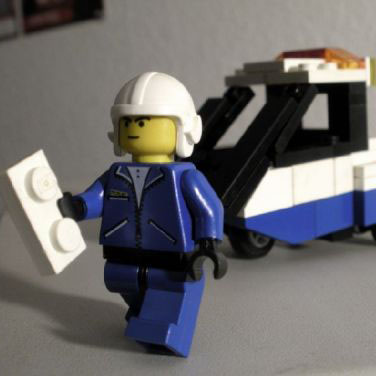My life in ATC began with 4 years Air Force then another 30 years with the Federal Aviation Admin. working tower & radar at some big international airports. I fought in the 1981 war with PATCO, survived the strike and kept a job that was just too exhilarating to walk away from. While there was nothing better than working airplanes, I did move on through several air traffic supervisory and management positions. It was a long, crazy career but I wouldn't trade a moment of it for love or lucre!
Hello Jim! Thanks for bringing up a very important issue. Whether pilot or controller; thunderstorms are the bane of their workday. All three factors you mentioned can affect the safety of flight. Lightning can be pretty disconcerting but not as dangerous to an airplane as you might imagine. Today’s planes are given extensive lightning certification tests to ensure the safety of their design. That could be why the last commercial plane crash attributed to lightning happened in 1967.
The lack of visibility, although a hazard in some instances, is not a major problem for pilots flying in or near thunderstorms. Rather than looking out the cockpit windows, they’re normally relying on the aircraft’s flight instruments to keep it properly oriented.
By far, the biggest safety hazard relates to the tricky winds found in and around those things! Accident investigation reports are rife with accounts of what can happen when airplanes experience the vertical wind shears and microbursts associated with thunderstorms (See Eastern Airlines Flight 66 landing JFK in 1975 or Delta Flight 191 landing DFW in 1985 as examples). Especially hazardous when planes are operating near the ground (taking off or landing), such winds can cause the aircraft’s wings to lose the lift they need to maintain flight. If this happens to a landing airplane (and it can happen instantly), all the available engine power may not be enough to save it.
When a plane loses the lift needed to maintain flight it becomes more like a brick that someone has thrown. It may still be traveling forward but only due to forward momentum and only for a very short time. I saw this happen from one of the control towers I worked in. An airliner flew through a thunderstorm situated on the final approach course and turned into that “brick” within a mile of the runway. When I finally saw the plane; it was no longer really flying but wallowing left and right as it fell. Fortunately, it fell onto the grass adjacent to the runway and eventually slid to a stop. The aircraft was destroyed but incredibly, there were no fatalities. I’ll tell you though; my shift couldn’t have ended fast enough.
Thank you for writing,
Factor
Good hearing from you Aaron. The gear-up landing at Newark was pretty dramatic. Whenever airplane bellies rub runways; sparks will fly! Your question is a good one because videos like the Newark landing show up in the news periodically, yet it’s hard to understand exactly what’s going on. People watch and wonder if a pilot can actually train for such a thing, how does it happen, what are the risks, etc.
First off; pilots obviously never make gear-up landings for practice. That would be kinda like practicing shooting yourself in the foot. The best way to rehearse for such an event is to practice landing WITH the landing gear extended. The trick will be in how the plane approaches the runway, which is going to be pretty much the same as a normal landing. The airplane will be slowed to the normal landing speed, with the nose pointed straight down the runway. Once over the runway, the pilot will ‘flare’ the aircraft; raising the nose to bleed off more speed as the plane descends those final few feet to the surface. Once on the runway, the pilot can use the aircraft’s rudder to try keeping the plane on the runway centerline.
How gear-up landings occur can vary. The most obvious reason is a mechanical malfunction. There is another, fairly common, reason. My flight instructor once told me that there are two kinds of pilots; those who’ve forgotten to put the gear down before landing and those who WILL forget! It’s not quite that extreme but sometimes pilots, especially pilots with low experience levels, can overlook that one important detail in an otherwise perfect landing. If there is an operational control tower at the airport; an alert controller may notice and have the pilot pull up before it’s too late. If the field is uncontrolled, the pilot may not be so lucky!
Risks associated with these landings are pretty much what you’d expect; lots of damage to the plane, a possibility of fire, personal injury and maybe even damage to the runway and associated lighting. No matter what happens – it’s never good and I do not recommend it!
Thanks for writing!
Factor
Greetings and thanks for writing. Although my opinion is worth a little more than a burned out matchstick; I’ll give it to you. I think you should contact the FAA Regional Office nearest you. A list of such offices can be found here:
http://www.faa.gov/about/office_org/headquarters_offices/arc/ro_center/
Ask to speak with someone who is directly involved in hiring controllers, Tell them of your situation and ask if they plan on hiring within your specific timeframe. Don’t be discouraged if they say they won’t be hiring. There are nine (9) FAA Regions and just because one of them has no upcoming vacancies doesn’t mean some or all of the other eight Regions won’t be hiring either. Give ‘em a call. When I was trying to get the job, my ‘home’ Region told me they were not currently hiring. They advised me to call another Regional Office (RO). I did - and that Region was indeed hiring. They also told me I’d have to have my application transferred from my ‘home’ RO to their office. Apparently at the time, you couldn’t have your name on more than one Region’s list of applicants. I don’t know if that is still the case or not but it’s a question to ask them.
If you run into a dead end with the FAA and are still determined to be a controller; contact one or all of the private companies who provide ATC services and ask if they’re hiring.
Best of luck to you!
Factor
Hello again and thanks for your questions! The subject of employment prospects may bring different responses, depending on who you ask. Controllers, especially those working in the busiest ATC facilities, will likely say they need more help. I worked in very busy places where the normal “minimum” staffing levels could quickly turn into “critical” staffing levels due to vacation schedules, sick leave and controllers on special details to administrative tasks. Throw in some bad weather, unusually high traffic demand or unplanned equipment outages and you’d end up with a bunch of drained and disgruntled people by shift’s end. Had you asked me your first question at the end of such a shift; I’d have said we needed more controllers, as soon as possible!
Management’s view varied; depending on how far they were from the epicenter of discontent. Shift supervisors generally felt the same heat as their controllers during a busy, understaffed shift. They’d usually agree we needed more help. The front office’s response was to point out that perhaps too much leave was approved or that not enough overtime was called in. The regional office, far from the immediacy of a hectic, understaffed shift, would only see the facility’s authorized staffing levels, performance figures (traffic count figures) and other numbers that belied the challenges associated with them.
FAA should also be mindful of the attrition rate of controllers due to retirement. Succession planning is an important factor in current and future staffing levels. Then, of course, somewhere far above our level, there are congressional committees working with the FAA on its annual budget request. Those folks are about as far from a controller’s daily reality as you can get. It’s like a crazy analogy where the leaves in the treetops place limits on how big the roots grow.
We should also keep in mind that the FAA is always seeking new technology that might automate certain controller functions, thus decreasing their recruitment needs.
Was my career worth it? Even with the occasionally unpleasant variables, I’d have to say emphatically; yes! I always considered myself lucky to have the best job there was. Like sky diving, sports car racing or skating on thin ice; it was a thrill - as long as nothing went wrong.
Sorry I had to give such convoluted answers to your “two simple questions.” Sometimes I drink too much coffee in the morning.
Cheers,
Factor
Stand-Up Comedian
 How do you fend off hecklers?
How do you fend off hecklers?
Waitress
 Are you instructed to "push" certain menu items that are at risk of going bad?
Are you instructed to "push" certain menu items that are at risk of going bad?
Meter Maid
 What's the meanest thing anyone's ever said to you?
What's the meanest thing anyone's ever said to you?
This is a good question and an easy one for me. Thanks for that! Some questions I get require answers that are a bit convoluted. When that happens, I worry that my explanations are not put together in a way that is easy to understand.
To your question; just remember it this way. You must be employed by the FAA prior to your 31st birthday. That’s it! So if you are hired a month before turning 31 and find yourself in class at the FAA Academy on your birthday; don’t worry. You will not be forcibly ejected! You probably won’t get a cake with candles either.
Cheers,
Factor
Hello “No. 1 Uncle,” and a happy 4th back at you! I hope you enjoyed a fabulous fireworks display.
In order to obtain a permit for public fireworks displays, the organizers must obtain approval from the Federal Aviation Administration. Any conditions the FAA imposes must be followed in order to receive that permit. The FAA then makes the information on such events available to those who need to know.
I can’t say there have never been aircraft accidents due to fireworks displays. Using absolutes like “always” or “never” tend to get me into trouble. I’ll just say I don’t recall hearing of any and that makes sense to me. After all, aeronautical charts clearly indicate minimum safe altitudes (MSA) to fly at. Planes rarely operate below the MSA unless they are taking off or landing. It’s a pretty safe bet your FAA won’t approve fireworks displays near an airport, along those departure or arrival paths. Besides, fireworks don’t go much higher that a few hundred feet. Certain flights do operate at those altitudes but only during daylight hours; a bad time for fireworks. These planes are involved in such things as crop-dusting, banner towing, aerial photography or some other low altitude mission.
I hope this answers your question. Thanks for writing!
Factor
Thanks for writing, JB. First off, I should mention that very few small airports have operating control towers. It is not cost effective to have controllers at airports with very little air traffic. Even if you see a tower there; chances are you’ll find far more cobwebs inside than controllers.
To your question though, I will break it down into a few important points. At airports without towers, most planes come and go as they please. They are responsible for separating themselves visually from other traffic. At such airports, the only pilots that need permission to take off are those who filed an Instrument Flight Plan with ATC. As there would be no controllers on site; permission is generally obtained from the ATC facility responsible for that airport, either by phone or radio. Pilots are issued a short time window in which to depart so that ATC knows when to expect them and provide ATC services.
At airports with operational towers, all flights must receive a specific clearance to take off and/or land. Without that ATC clearance; pilots can do neither.
There are also airports with part-time control towers. When the tower is open, the rules specified in the previous paragraph apply. When it is closed, expect what I outlined two paragraphs back. There are several publications available that list all towers and their operating hours, so you’ll know what to expect when you go flying.
You also asked if a tower is required to keep a schedule for take offs, even if they have say less than one a day. Although towers do not generally keep flight schedules, they do receive information on the proposed departure time of flights on Instrument Flight Plans. This information is normally transmitted to the tower via computer.
I hope this answers your questions!
Cheers,
Factor
-OR-
 Login with Facebook
Login with Facebook (max 20 characters - letters, numbers, and underscores only. Note that your username is private, and you have the option to choose an alias when asking questions or hosting a Q&A.)
(A valid e-mail address is required. Your e-mail will not be shared with anyone.)
(min 5 characters)
By checking this box, you acknowledge that you have read and agree to Jobstr.com’s Terms and Privacy Policy.
-OR-
 Register with Facebook
Register with Facebook(Don't worry: you'll be able to choose an alias when asking questions or hosting a Q&A.)